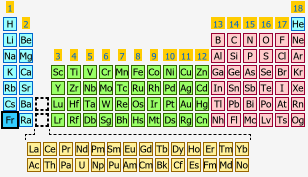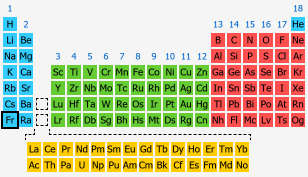References (Click the
 next to a value above to see complete citation information for that entry)
next to a value above to see complete citation information for that entry)
Bratsch, Steven G. "Revised Mulliken Electronegativities: I. Calculation and Conversion to Pauling Units." Journal of Chemical Education, volume 65, number 1, 1988, pp. 34–41. doi:10.1021/ed065p34
Campbell, J. L. "Fluorescence Yields and Coster–Kronig Probabilities for the Atomic L Subshells. Part II: The L1 Subshell Revisited." Atomic Data and Nuclear Data Tables, volume 95, number 1, 2009, pp. 115–124. doi:10.1016/j.adt.2008.08.002
Campbell, J. L. "Fluorescence Yields and Coster–Kronig Probabilities for the Atomic L Subshells." Atomic Data and Nuclear Data Tables, volume 85, number 2, 2003, pp. 291–315. doi:10.1016/S0092-640X(03)00059-7
Chi, T. C. "Electrical Resistivity of Alkali Elements." Journal of Physical and Chemical Reference Data, volume 8, number 2, 1979, pp. 339–438.
Journal of Physical and Chemical Reference Data, volume 8, number 2, 1979, pp. 339–438.
Cohen, E. Richard, David R. Lide, and George L. Trigg, editors. AlP Physics Desk Reference, 3rd edition. New York: Springer-Verlag New York, Inc., 2003.
Connelly, Neil G., Ture Damhus, Richard M. Hartshorn, and Alan T. Hutton. Nomenclature of Inorganic Chemistry: IUPAC Recommendations 2005. Cambridge: RSC Publishing, 2005.
Cambridge: RSC Publishing, 2005.
Cordero, Beatriz, Verónica Gómez, Ana E. Platero-Prats, Marc Revés, Jorge Echeverría, Eduard Cremades, Flavia Barragán, and Santiago Alvarez. "Covalent Radii Revisited." Dalton Transactions, number 21, 2008, pp 2832–2838. doi:10.1039/b801115j
de Podesta, Michael. Understanding the Properties of Matter, 2nd edition. London: Taylor & Francis, 2002.
Dronskowski, Richard. Computational Chemistry of Solid
State Materials. Weinheim, Germany: WILEY-VCH Verlag GmbH & Co. KGaA, 2005.
Eliav, Ephraim, Marius J. Vilkas, Yasuyuki Ishikawa, and Uzi Kaldor. "Extrapolated Intermediate Hamiltonian Coupled-Cluster Approach: Theory and Pilot Application to Electron Affinities of Alkali Atoms." Journal of Chemical Physics, volume 122, number 22, 2005, pp. 224113–1 to 224113–5. doi:10.1063/1.1929727
Emsley, John. Nature's Building Blocks: An A-Z Guide to the Elements. Oxford: Oxford University Press, 2003.
Emsley, John. The Elements, 3rd edition. Oxford: Oxford University Press, 1998.
Firestone, Richard B. Table of Isotopes,
8th edition, volume 2. Edited by Virginia S. Shirley, with assistant editors Coral M. Baglin, S. Y. Frank Chu, and Jean Zipkin. New York: John Wiley & Sons, Inc., 1996.
Greenwood, N. N., and A. Earnshaw. Chemistry of the Elements, 2nd edition. Oxford: Butterworth-Heinemann, 1997.
Gwyn Williams. Electron Binding Energies. http://www.jlab.org/~gwyn/ebindene.html . Accessed on April 30, 2010.
. Accessed on April 30, 2010.
Ho, C. Y., R. W. Powell, and P. E. Liley. "Thermal Conductivity of the Elements: A Comprehensive Review." Journal of Physical and Chemical Reference Data, volume 3, supplement 1, 1974, pp. I–1 to I–796.
Journal of Physical and Chemical Reference Data, volume 3, supplement 1, 1974, pp. I–1 to I–796.
Horvath, A. L. "Critical Temperature of Elements and the Periodic System." Journal of Chemical Education, volume 50, number 5, 1973, pp. 335–336. doi:10.1021/ed050p335
Huheey, James E., Ellen A. Keiter, and Richard L Keiter. Inorganic Chemistry: Principles of Structure and Reactivity, 4th edition. New York: HarperCollins College Publishers, 1993.
Ihde, Aaron J. The Development of Modern Chemistry. New York: Dover Publications, Inc., 1984.
Jr., Elbert J. Little,, and Mark M. Jones. "A Complete Table of Electronegativities." Journal of Chemical Education, volume 37, number 5, 1960, pp. 231–233. doi:10.1021/ed037p231
Kittel, Charles. Introduction to Solid State Physics, 8th edition. Hoboken, NJ: John Wiley & Sons, Inc, 2005.
Liboff, Richard L. Introductory Quantum Mechanics, 3rd edition. Reading, MA: Addison Wesley Longman, Inc., 1998.
Lide, David R., editor. CRC Handbook of Chemistry and Physics, 88th edition. Boca Raton, Florida: Taylor & Francis Group, 2008.
Marshall, James L. Discovery of the Elements: A Search
for the Fundamental Principles of the Universe, 2nd edition. Boston, MA: Pearson Custom Publishing, 2002.
Martin, W. C. "Electronic Structure of the Elements." The European Physical Journal C — Particles and Fields, volume 15, number 1–4, 2000, pp. 78–79. doi:10.1007/BF02683401
Miessler, Gary L., and Donald A. Tarr. Inorganic Chemistry, 3rd edition. Upper Saddle River, NJ: Pearson Prentice Hall, 2004.
Nagle, Jeffrey K. "Atomic Polarizability and Electronegativity." Journal of the American Chemical Society, volume 112, number 12, 1990, pp. 4741–4747. doi:10.1021/ja00168a019
Oxtoby, David W., H. P. Gillis, and Alan Campion. Principles of Modern Chemistry, 6th edition. Belmont, CA: Thomson Brooks/Cole, 2008.
Pauling, Linus. The Nature of the Chemical Bond,
3rd edition. Ithaca, NY: Cornell University Press, 1960.
Pekka Pyykkö. Self-Consistent, Year-2009 Covalent Radii. http://www.chem.helsinki.fi/~pyykko/Radii09.pdf . Accessed on
November 20, 2010.
. Accessed on
November 20, 2010.
Pyykkö, Pekka, and Michiko Atsumi. "Molecular Double-Bond Covalent Radii for Elements Li-E112." Chemistry - A European Journal, volume 15, number 46, 2009, pp. 12770–12779. doi:10.1002/chem.200901472
Pyykkö, Pekka, and Michiko Atsumi. "Molecular Single-Bond Covalent Radii for Elements 1-118." Chemistry - A European Journal, volume 15, number 1, 2009, pp. 186–197. doi:10.1002/chem.200800987
Ringnes, Vivi. "Origin of the Names of Chemical Elements." Journal of Chemical Education, volume 66, number 9, 1989, pp. 731–738. doi:10.1021/ed066p731
Rohrer, Gregory S. Structure and Bonding in Crystalline Materials. Cambridge: Cambridge University Press, 2001.
Sansonetti, J. E., and W. C. Martin. "Handbook of Basic Atomic Spectroscopic Data." Journal Of Physical And
Chemical Reference Data, volume 34, number 4, 2005, pp. 1559–2259. doi:10.1063/1.1800011
Journal Of Physical And
Chemical Reference Data, volume 34, number 4, 2005, pp. 1559–2259. doi:10.1063/1.1800011
Shannon, R. D. "Revised Effective Ionic Radii and Systematic Studies of Interatomic Distances in Halides and Chalcogenides." Acta
Crystallographica Section A, volume 32, number 5, 1976, pp. 751–767. doi:10.1107/S0567739476001551
Silbey, Robert J., Robert A. Alberty, and Moungi G. Bawendi. Physical Chemistry, 4th edition. Hoboken, NJ: John Wiley &
Sons, Inc., 2005.
Waber, J. T., and Don T. Cromer. "Orbital Radii of Atoms and Ions." Journal of Chemical Physics, volume 42, number 12, 1965, pp. 4116–4123. doi:10.1063/1.1695904
Weeks, Mary Elvira, and Henry M. Leicester. Discovery of the Elements, 7th edition. Easton, PA: Journal of Chemical Education, 1968.
Yaws, Carl L. The Yaws Handbook of Physical Properties for Hydrocarbons and Chemicals. Houston, TX: Gulf Publishing Company, 2005.















































 next to a value above to see complete citation information for that entry)
next to a value above to see complete citation information for that entry)


 Journal of Physical and Chemical Reference Data, volume 8, number 2, 1979, pp. 339–438.
Journal of Physical and Chemical Reference Data, volume 8, number 2, 1979, pp. 339–438. Cambridge: RSC Publishing, 2005.
Cambridge: RSC Publishing, 2005.

 . Accessed on April 30, 2010.
. Accessed on April 30, 2010. Journal of Physical and Chemical Reference Data, volume 3, supplement 1, 1974, pp. I–1 to I–796.
Journal of Physical and Chemical Reference Data, volume 3, supplement 1, 1974, pp. I–1 to I–796.



 . Accessed on
November 20, 2010.
. Accessed on
November 20, 2010.


 Journal Of Physical And
Chemical Reference Data, volume 34, number 4, 2005, pp. 1559–2259. doi:10.1063/
Journal Of Physical And
Chemical Reference Data, volume 34, number 4, 2005, pp. 1559–2259. doi:10.1063/




